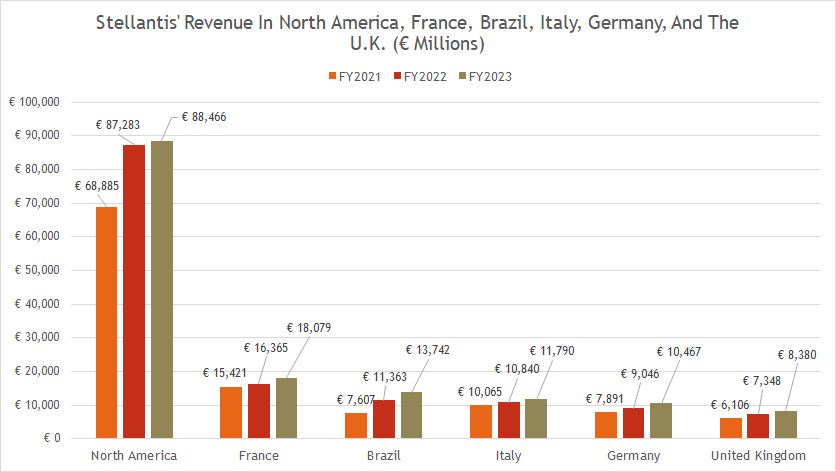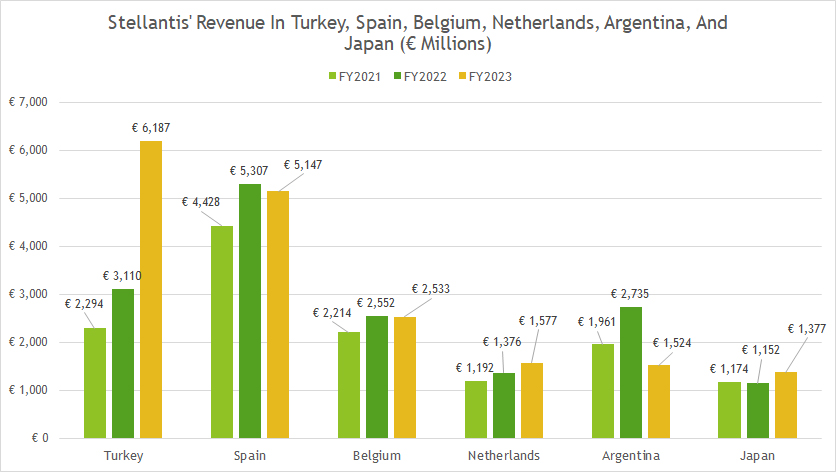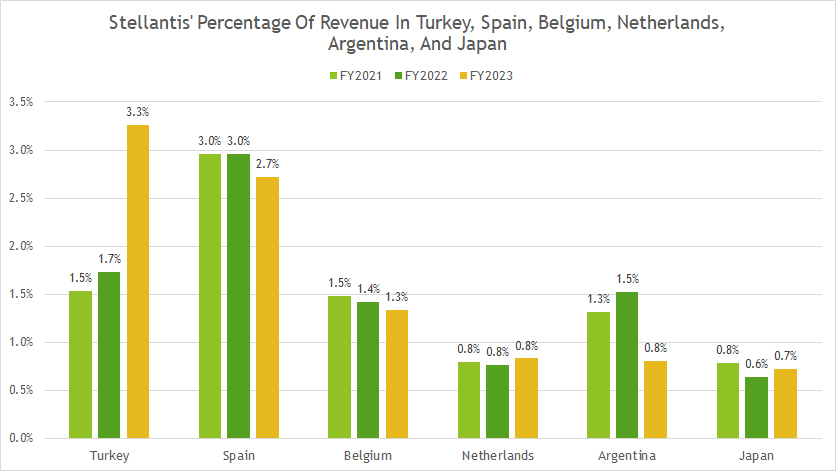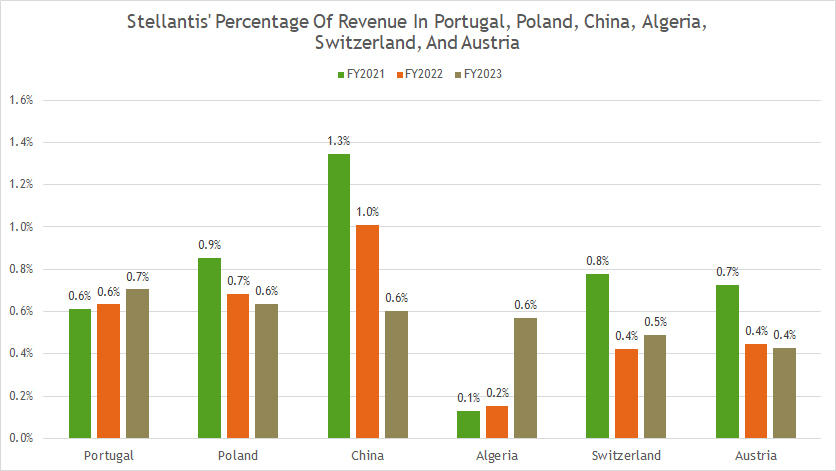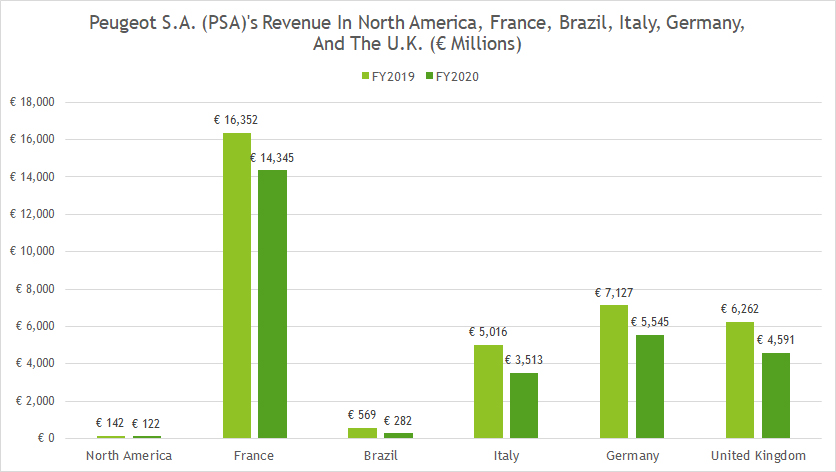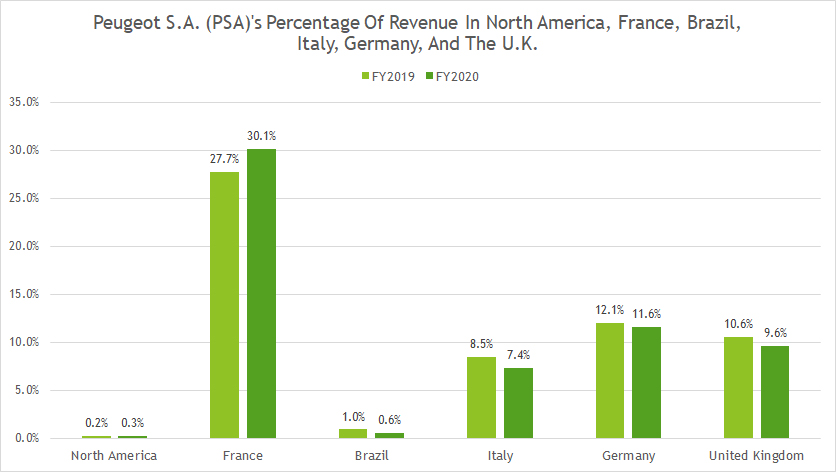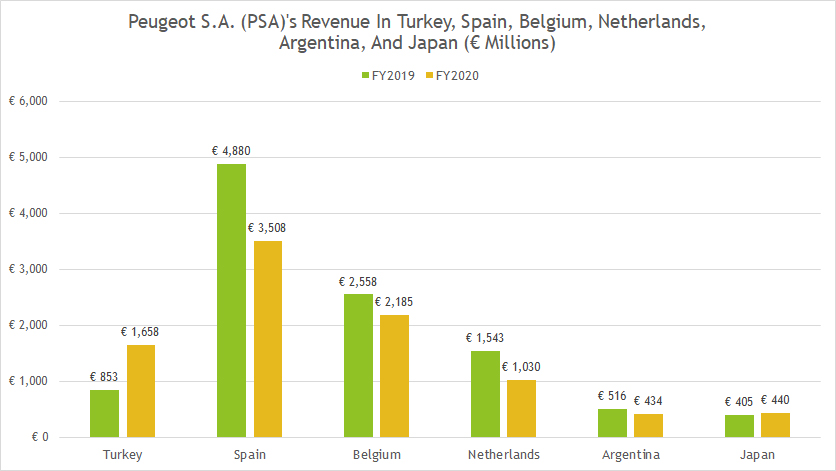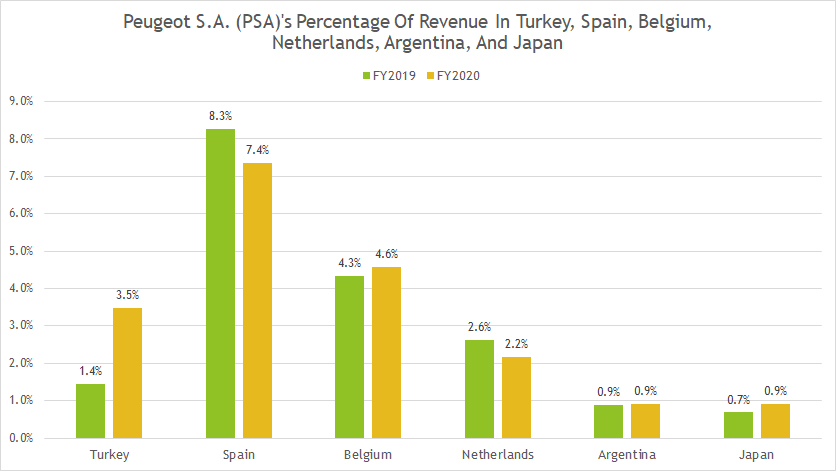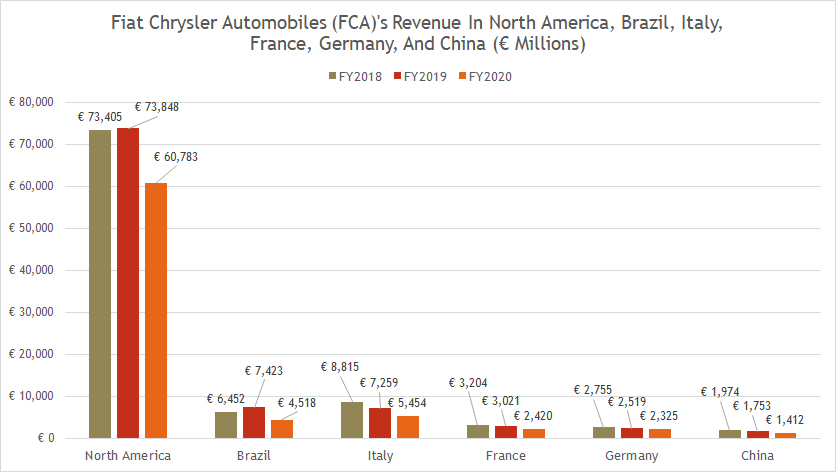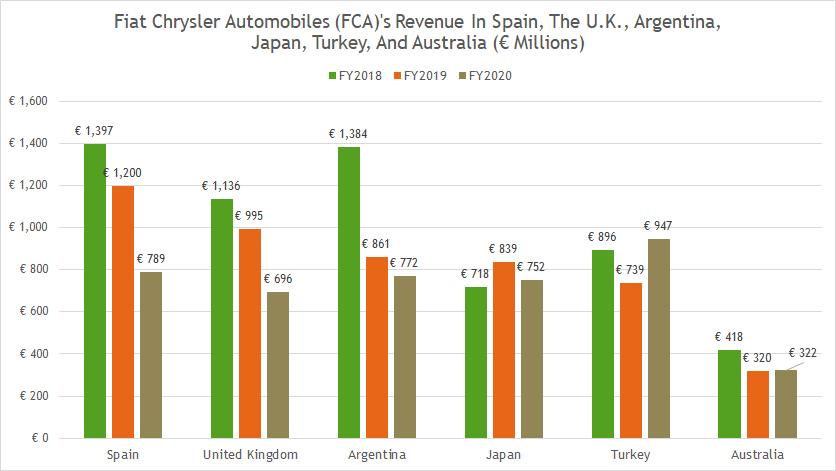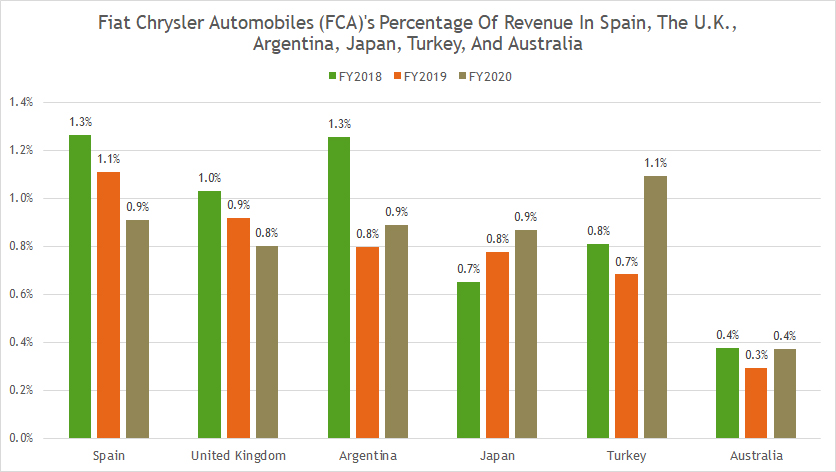
Euro. Pixabay image.
Stellantis is a multinational automotive manufacturer formed in 2021 through the merger of the Italian-American conglomerate Fiat Chrysler Automobiles (FCA) and the French PSA Group.
The company’s name, “Stellantis,” is derived from the Latin verb “stello,” meaning “to brighten with stars.” It is one of the world’s largest automakers, offering a wide range of automotive brands, including Alfa Romeo, Chrysler, Citroën, Dodge, DS Automobiles, Fiat, Jeep, Maserati, Opel, Peugeot, Ram, and Vauxhall.
Stellantis operates with a strong global presence, aiming to leverage the strengths of its constituent companies to innovate and compete in the rapidly evolving automotive market, particularly in electric vehicles and sustainable mobility.
This article presents Stellantis’ revenue by country and region. Apart from the revenue of Stellantis, we also look at the company’s revenue before the merger. For example, we will explore Peugeot S.A. (PSA)’s revenue by country and region as well as that of Fiat Chrysler Automobiles (FCA).
For vehicle sales and market share of a specific region and country, you may find more information on this page: Stellantis sales numbers.
Investors interested in Stellantis’ revenue breakdown by product category and profit margin may find more information on this page: Stellantis revenue streams and profit margin.
Let’s take a look!
Please use the table of contents to navigate this page.
Table Of Contents
Definitions And Overview
O2. How Does Stellantis Make Money
Stellantis Revenue By Country – First Tier
A1. North America, France, Brazil, Italy, Germany, And The U.K.
A2. North America, France, Brazil, Italy, Germany, And The U.K. In Percentage
Stellantis Revenue By Country – Second Tier
A3. Turkey, Spain, Belgium, Netherlands, Argentina, And Japan
A4. Turkey, Spain, Belgium, Netherlands, Argentina, And Japan In Percentage
Stellantis Revenue By Country – Third Tier
A5. Portugal, Poland, China, Algeria, Switzerland, And Austria
A6. Portugal, Poland, China, Algeria, Switzerland, And Austria In Percentage
PSA Revenue By Country – First Tier
B1. North America, France, Brazil, Italy, Germany, And The U.K.
B2. North America, France, Brazil, Italy, Germany, And The U.K. In Percentage
PSA Revenue By Country – Second Tier
B3. Turkey, Spain, Belgium, Netherlands, Argentina, And Japan
B4. Turkey, Spain, Belgium, Netherlands, Argentina, And Japan In Percentage
PSA Revenue By Country – Third Tier
B5. Portugal, Poland, China, Algeria, Switzerland, And Austria
B6. Portugal, Poland, China, Algeria, Switzerland, And Austria In Percentage
FCA Revenue By Country – First Tier
C1. North America, Brazil, Italy, France, Germany, And China
C2. North America, Brazil, Italy, France, Germany, And China In Percentage
FCA Revenue By Country – Second Tier
C3. Spain, United Kingdom, Argentina, Japan, Turkey, And Australia
C4. Spain, United Kingdom, Argentina, Japan, Turkey, And Australia In Percentage
Conclusion And Reference
S1. Conclusion
S2. References and Credits
S3. Disclosure
Definitions
To help readers understand the content better, the following terms and glossaries have been provided.
FCA-PSA Merger: The FCA-PSA merger refers to the combination of Fiat Chrysler Automobiles (FCA) and Peugeot S.A. (PSA) to form a new entity called Stellantis.
Announced in 2019 and completed in January 2021, the merger created the fourth-largest automaker in the world by volume. The move was aimed at leveraging the strengths of both companies to compete more effectively in a rapidly evolving automotive industry, particularly with the shift towards electric vehicles and autonomous driving technologies.
The merger brought together a broad portfolio of brands, including Fiat, Jeep, Dodge, Ram, Peugeot, Citroën, and Opel. Stellantis aims to utilize economies of scale, share technology and platforms, and optimize its global manufacturing footprint to improve efficiency and competitiveness.
Under accounting standards, Groupe PSA (“PSA”) was identified as the acquirer in the FCA-PSA merger, which was accounted for as a reverse acquisition, under IFRS 3 – Business Combinations, and, as such, it contributed to the results of Stellantis beginning January 1, 2021. FCA was consolidated into Stellantis effective January 17, 2021, the day after the merger became effective.
How Does Stellantis Make Money
Stellantis makes money through several key revenue streams, primarily focusing on the automotive industry. As a global automaker formed by merging Fiat Chrysler Automobiles (FCA) and the PSA Group, Stellantis operates in various automotive markets, including North America, Europe, and other regions. The main ways Stellantis generates income include:
1. **Vehicle Sales**: The most significant source of revenue for Stellantis comes from selling vehicles. This consists of a wide variety of brands under its umbrella, such as Jeep, Ram, Peugeot, Citroën, Fiat, Chrysler, Dodge, and Alfa Romeo, among others. Stellantis sells passenger cars, trucks, and commercial vehicles.
2. **Parts and Accessories**: Another revenue stream is selling automotive parts and accessories. This includes original equipment manufacturer (OEM) parts used for vehicle repairs and maintenance and aftermarket parts and accessories for customization and enhancement.
3. **Financial Services**: Stellantis also profits from financial services offered to dealers and customers. This encompasses financing for vehicle purchases or leases and dealer financing. These services help facilitate the sale of vehicles and generate additional income through interest payments and financing fees.
4. **Other Ventures**: Beyond its core automotive operations, Stellantis is involved in several other ventures contributing to its revenue. This includes mobility services, such as car sharing and subscription services, and potentially revenue from technological advancements like electric vehicles (EVs) and autonomous driving technologies.
Stellantis’s diversification across different brands, markets, and services allows it to cater to a wide range of customer preferences and adapt to changing market trends, all of which are crucial for its financial success.
North America, France, Brazil, Italy, Germany, And The U.K.
Stellantis-revenue-by-country-tier-1
(click image to expand)
A definition of the FCA-PSA merger is available here: FCA-PSA Merger.
Stellantis earns the most revenue in these countries or regions. For example, Stellantis has earned an average of €81.5 billion in revenue in North America between 2021 and 2023, while revenue from France has come to €16.6 on average in the past three years.
Brazil generates the third-highest revenue for Stellantis, averaging €10.9 billion between 2021 and 2023. Italy and Germany both have produced €10.9 billion and €9.1 billion, respectively, on average since 2021.
Stellantis earned approximately €6.1 billion, €7.3 billion, and €8.4 billion in revenue in the United Kingdom in fiscal years 2021, 2022, and 2023, respectively.
A noticeable trend is the significant rise in revenue in these countries and regions over the last three years. Among all countries and regions shown in the chart above, Brazil has probably been the fastest growing. For example, Stellantis’ revenue in Brazil has nearly doubled since 2021.
North America, France, Brazil, Italy, Germany, And The U.K. In Percentage
Stellantis-revenue-by-country-tier-1-in-percentage
(click image to expand)
A definition of the FCA-PSA merger is available here: FCA-PSA Merger.
You can see that North America contributes nearly 50% of sales to total revenue for Stellantis, making this region the largest revenue contributor for the company. On average, Stellantis has derived 47% of its revenue from the North American region between 2021 and 2023.
What follows North America is France. The revenue contribution from France is the second-highest, averaging 9.7% in the last three years.
For the rest of the countries such as Brazil, Italy, Germany, and the United Kingdom, the revenue contribution has averaged 6.2%, 6.3%, 5.3%, and 4.2%, respectively, between 2021 and 2023.
Turkey, Spain, Belgium, Netherlands, Argentina, And Japan
Stellantis-revenue-by-country-tier-2
(click image to expand)
A definition of the FCA-PSA merger is available here: FCA-PSA Merger.
These countries contribute substantial revenue to Stellantis, but is significantly less than the first-tier countries which we saw earlier.
As seen, Stellantis’ revenue in Turkey has significantly risen since 2021, topping a record figure of €6.2 billion as of 2023.
Stellantis has earned an average of €5.0 billion, €2.4 billion, and €1.4 billion in revenue in Spain, Belgium, and Netherlands, respectively, over the last three years.
On the other hand, the company’s revenue in Argentina and Japan has averaged only €2.0 billion and €1.2 billion, respectively, between 2021 and 2023.
Turkey, Spain, Belgium, Netherlands, Argentina, And Japan In Percentage
Stellantis-revenue-by-country-tier-2-in-percentage
(click image to expand)
A definition of the FCA-PSA merger is available here: FCA-PSA Merger.
The revenue contribution from these countries is significantly less than that of the first-tier countries.
For example, Stellantis earned only 3.3% of revenue from Turkey in fiscal year 2023, while the ratio for Spain came to only 2.7% in the same period. Belgium has contributed an average of 1.4% of revenue to the company over the last three years.
Stellantis earns less than 1% of revenue in Netherlands, Argentina, and Japan.
Portugal, Poland, China, Algeria, Switzerland, And Austria
Stellantis-revenue-by-country-tier-3
(click image to expand)
A definition of the FCA-PSA merger is available here: FCA-PSA Merger.
Stellantis earns significantly less revenue in these countries. However, Stellantis’ revenue from China was quite substantial in the past, topping over €2.0 billion in fiscal 2021. Nevertheless, the company’s revenue in China has significantly decreased since 2021, reaching only €1.1 billion Euro as of 2023.
Stellantis’ revenue in Portugal, Poland, and Algeria has averaged €1.1 billion, €1.2 billion, and €0.5 billion, respectively, over the last three years. On the other hand, the average figures for Switzerland and Austria were €951 million and €899 million respectively.
Although Stellantis has not earned substantial revenue in these countries, its revenue in Algeria has considerably risen. Since 2021, Stellantis’ revenue in Algeria has more than quintupled or increased by fivefold.
Portugal, Poland, China, Algeria, Switzerland, And Austria In Percentage
Stellantis-revenue-by-country-tier-3-in-percentage
(click image to expand)
A definition of the FCA-PSA merger is available here: FCA-PSA Merger.
The revenue contribution from these countries has averaged less than 1% in the last three years. The exception is that China contributed around 1.3% of revenue to Stellantis in fiscal year 2021. However, this ratio decreased to only 0.6% as of 2023.
As of 2023, Portugal, Poland, Algeria, Switzerland, and Austria contributed the same level of revenue to Stellantis as China.
North America, France, Brazil, Italy, Germany, And The U.K.
Peugeot-revenue-by-country-tier-1
(click image to expand)
A definition of the FCA-PSA merger is available here: FCA-PSA Merger.
Before the merger, Peugeot S.A. (PSA) literally had no sales in North America. As seen, PSA’s revenue in North America totaled only around €100 million.
PSA’s revenue was mostly concentrated in Europe and the majority of sales were from France, as shown in the chart above. PSA earned about €16.4 billion and €14.3 billion in revenue in fiscal years 2019 and 2020, respectively, in France.
PSA’s revenue in South America, particularly in Brazil, totaled about €569 million in 2019. This figure decreased to €282 million in 2020.
PSA earned substantial revenue in Italy, Germany, and the United Kingdom, averaging €4.3 billion, €6.3 billion, and €5.4 billion, respectively, between 2019 and 2020.
A significant trend is PSA’s significant revenue decrease in some of the European countries. For example, PSA’s revenue in France and Italy has decreased by 13% and 43%, respectively, between 2019 and 2020. In Germany and the United Kingdom, PSA’s revenue has decreased by 22% and 27%, respectively, between 2019 and 2020.
North America, France, Brazil, Italy, Germany, And The U.K. In Percentage
Peugeot-revenue-by-country-tier-1-in-percentage
(click image to expand)
A definition of the FCA-PSA merger is available here: FCA-PSA Merger.
Peugeot S.A. (PSA) had very little presence in North America. It derived only 0.2% and 0.3% of revenue in North America in fiscal years 2019 and 2020, respectively.
On the other hand, PSA earned substantial revenue in Europe. In France, PSA’s revenue share reached 30.1% in fiscal 2020 and over 10% in Germany and the United Kingdom.
The revenue contribution from Italy was in high single digits in fiscal year 2019 and 2020.
Turkey, Spain, Belgium, Netherlands, Argentina, And Japan
Peugeot-revenue-by-country-tier-2
(click image to expand)
A definition of the FCA-PSA merger is available here: FCA-PSA Merger.
Again, Peugeot S.A. (PSA)’s revenue is mostly concentrated in European countries such as Spain, Belgium, and Netherlands. As seen, PSA’s revenue in Spain, Belgium, and Netherlands totaled a minimum of €1.0 billion per year.
PSA’s sales in South America and Asia were only about half of the numbers in European countries. For example, PSA earned revenue of just €434 million in Argentina in 2020, while the figure was only €440 million in Japan.
Turkey, Spain, Belgium, Netherlands, Argentina, And Japan In Percentage
Peugeot-revenue-by-country-tier-2-in-percentage
(click image to expand)
A definition of the FCA-PSA merger is available here: FCA-PSA Merger.
As depicted in the chart above, Peugeot S.A. (PSA) derived the majority of its revenue in European countries such as Spain, Belgium, and the Netherlands. The revenue contribution from Spain, Belgium, and the Netherlands reached 7.4%, 4.6%, and 2.2%, respectively, in fiscal years 2020.
Similarly, Turkey contributed significantly to PSA’s revenue streams, totaling 3.5% of the total in fiscal 2020. In contrast, PSA earned less than 1% of revenue in Argentina and Japan.
Portugal, Poland, China, Algeria, Switzerland, And Austria
Peugeot-revenue-by-country-tier-3
(click image to expand)
A definition of the FCA-PSA merger is available here: FCA-PSA Merger.
Peugeot S.A. (PSA) had very little presence in China, as shown in the chart above. Its revenue in China in 2019 and 2020 totaled only €175 million and €133 million, respectively.
On the other hand, PSA earned much higher revenue in European countries such as Portugal, Poland, Switzerland, and Austria. However, PSA’s revenue in these European countries had significantly decreased. For example, PSA’s revenue in Switzerland was reduced by half in 2020 from 2019, reaching only €361 million in 2020.
Similarly, PSA earned €753 million in revenue in fiscal year 2020, down 37% over 2019, while revenue in Austria was down 22% year-on-year in the same period.
Portugal, Poland, China, Algeria, Switzerland, And Austria In Percentage
Peugeot-revenue-by-country-tier-3-in-percentage
(click image to expand)
A definition of the FCA-PSA merger is available here: FCA-PSA Merger.
Peugeot S.A. (PSA)’s presence in China was insignificant, with revenue contribution from this region totaling only 0.3% in fiscal year 2020.
On the other hand, PSA had 1.5%, 1.6%, 0.8%, and 1.4% of revenue contribution from Portugal, Poland, Switzerland, and Austria, respectively, in fiscal year 2020.
North America, Brazil, Italy, France, Germany, And China
Fiat-Chrysler-Automobiles-revenue-by-country-tier-1
(click image to expand)
A definition of the FCA-PSA merger is available here: FCA-PSA Merger.
Fiat Chrysler Automobiles (FCA) operated in markets that were vastly different from Peugeot S.A. (PSA). In this aspect, FCA’s market was concentrated in the North American region, as depicted in the chart above.
The company earned significant revenue in North America, totaling over €60.8 billion in fiscal year 2020. On the other hand, FCA had very little presence in Europe. It earned less than €5 billion in annual revenue in most European countries, as shown in the chart above.
FCA’s revenue in China was considerably less, reaching just €1.4 billion in fiscal 2020.
North America, Brazil, Italy, France, Germany, And China In Percentage
Fiat-Chrysler-Automobiles-revenue-by-country-tier-1-in-percentage
(click image to expand)
A definition of the FCA-PSA merger is available here: FCA-PSA Merger.
These countries produced the most revenue for Fiat Chrysler Automobiles (FCA).
The revenue contribution from North America reached a staggering 70.1% of the total for FCA in fiscal year 2020, the largest among all countries under comparison.
Although FCA derived a significant portion of revenue from North America, it only had a modest presence in South America. As seen, FCA’s revenue in Brazil reached just 5.2% of the total in fiscal year 2020, and Brazil seemed like the only country in South America where revenue share was above 5% for the company.
In Europe, FCA does not seem to have a significant presence. Revenue contribution from Italy, France, and Germany totaled only 6.3%, 2.8%, and 2.7% of the total in fiscal year 2020.
FCA has an even lower presence in China. For example, revenue contribution from China totaled just 1.6% in fiscal year 2020.
Spain, United Kingdom, Argentina, Japan, Turkey, And Australia
Fiat-Chrysler-Automobiles-revenue-by-country-tier-2
(click image to expand)
A definition of the FCA-PSA merger is available here: FCA-PSA Merger.
These countries produced the least revenue for Fiat Chrysler Automobiles (FCA).
FCA earned only €789 million in Spain in fiscal year 2020, while revenue from the United Kingdom declined to just €696 million in the same period.
FCA earned roughly the same revenue in Argentina and Japan, at €750 million in fiscal year 2020. However, FCA’s revenue in Argentina had been reduced by half between 2018 and 2020, while revenue in Japan had remained relatively unchanged during the same period.
FCA’s revenue in Turkey soared to nearly €1.0 billion in fiscal year 2020, the highest among all countries under comparison in this group. On the other hand, FCA earned just €322 million in Australia in fiscal year 2020.
Spain, United Kingdom, Argentina, Japan, Turkey, And Australia In Percentage
Fiat-Chrysler-Automobiles-revenue-by-country-tier-2-in-percentage
(click image to expand)
A definition of the FCA-PSA merger is available here: FCA-PSA Merger.
Fiat Chrysler Automobiles (FCA) earned significantly less revenue in these countries, as shown in the chart above.
For example, revenue contribution from Spain, the U.K., and Argentina totaled less than 1% in fiscal year 2020. On the other hand, revenue contribution from Turkey rose to 1.1% during the same period, the highest among all countries in this group.
FCA earned just 0.4% of revenue in Australia in 2020, while Japan contributed 0.9%, a significant decrease from 1.3% in 2018.
Conclusion
After merging FCA and PSA, Stellantis’ revenue has significantly increased. This trend is particularly obvious in North America, with revenue reaching €88 billion in fiscal year 2023, the largest among all countries and regions under comparison. Stellantis’ revenue from North America contributed 46.7% of the total in fiscal year 2023.
Before the merger, Peugeot S.A. (PSA)’s revenue was concentrated primarily in Europe, while Fiat Chrysler Automobiles (FCA)’s revenue was distributed primarily in North America.
Stellantis’ revenue is more evenly distributed after the merger. The revenue contribution from European countries exceeded 30% in fiscal year 2023, only slightly behind that of North America.
References and Credits
1. All financial figures presented in this article were obtained and referenced from Stellantis’ quarterly and annual reports, SEC filings, investor presentations, press releases, earnings reports, etc., which are available in Stellantis Investor Relation.
2. Pixabay images.
Disclosure
References and examples such as tables, charts, and diagrams are constantly reviewed to avoid errors, but we cannot warrant the total correctness of all content.
The content in this article is for informational purposes only and is neither a recommendation nor a piece of financial advice to purchase a stock.
If you find the information in this article helpful, please consider sharing it on social media and provide a link to it from any website to create more articles like this.
Thank you!

